THE EXPERIMENT THAT SHOCKED THE WORLD
By: Andrew Lai
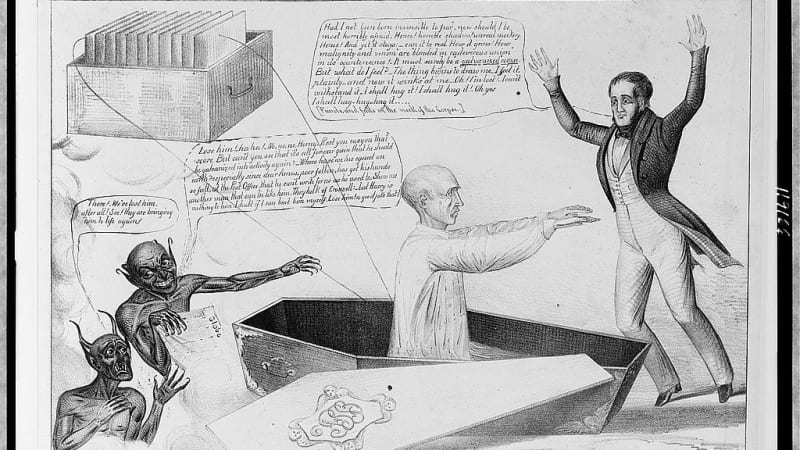
A Galvanized corpse. Published in 1836, this cartoon depicts Galvani’s nephew electrifying a criminal’s corpse.
Established pillars were under attack across the Western world. It was the late 1700s, and the United States had just declared independence. France was rapidly heading towards a bloody revolution. Industrialization was beginning to reshape society. And, amidst the chaos, an obscure Italian physiologist stepped outside to do a science experiment.
In his back garden, all of his equipment lay ready. The lightning rod was installed. A frog corpse lay on the table. A storm was coming. All that remained was the final touch: connecting the lightning rod to the frog. Then, after making the connection, it was time to wait.
At long last, the storm came. Whenever lightning flashed nearby, energy coursed down the rod and the frog’s leg twitched!
The scientist, Luigi Galvani, must have been ecstatic. Over the past several years, he had come to believe that electricity was linked to movement. He had already shown that his static electricity generator made frog legs twitch in controlled laboratory conditions. Here was a piece of evidence to improve his theory: a connection between naturally occurring electricity and movement. In those moments, Galvani must have felt like he was on to something. Maybe this was the key to movement, the key to life!
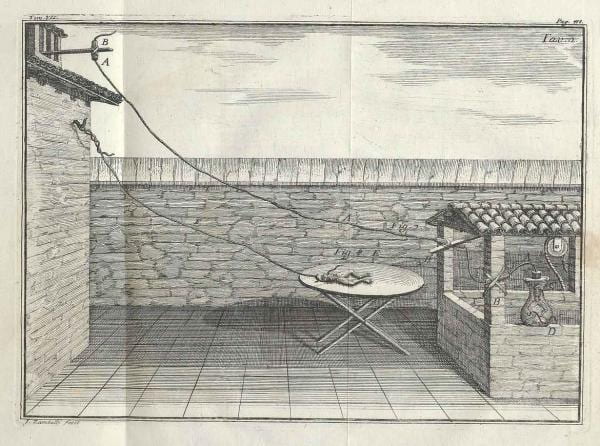
Figure 1. The original print from Galvani’s 1791 publication. An illustration of Galvani’s setup, depicting a dead frog connected to a lightning rod.
In the years that followed, the lightning experiment became a piece of Galvani’s magnum opus: the theory that animals generate electricity – and they use this intrinsic electricity to make their body move. This theory of “animal electricity” sent shockwaves throughout the scientific community, medical community, and the communities of everyday people.
The first reverberations hit the community of scientists studying movement. Up until Galvani’s time, the field of movement studies was a chaotic scientific wilderness. In the 18th century, scientists held many different beliefs regarding the impetus that caused muscles to contract, many of them mystical in nature. Many scientists and doctors still believed in a theory harking back to the Ancient Greeks. They believed the body was governed by pneuma, a psychic fluid that was said to control all movements.
As a result, the scientific climate was replete with superstition and tribal alliances. As one member of the Royal Society of London observed (a mere three years before Galvani published his results), “No argument from fact has been employed to prove any [theory of muscular movements]: I shall therefore leave them as mere chimeras of the brain” (emphasis mine).
Galvani’s theory provided the “argument from fact” that was so badly needed. With animal electricity theory, scientists were able to verify their scientific hypotheses using electrical equipment. Armed with this new way to think about movement, the study of human physiology became increasingly grounded in physics, and less grounded in mystical beliefs. And, if only a little bit, movement scientists pushed the scientific frontier further into the distance.
Galvani’s work also sent shockwaves far beyond the small community of muscle movement scientists. The ripples of animal electricity were felt by many, but the theory was most transformative in the life of Allenssandro Volta. At the time, Volta was a Professor of Physics in Pavia, Italy. After reading Galvani’s work, Volta felt so inspired that he performed his own animal electricity experiments. But, Volta gradually became concerned that one of Galvani’s experiments had led to a false conclusion.
In the disputed experiment, Galvani had connected a frog’s leg to its spinal cord using two different pieces of metal (these metals were usually iron and bronze or iron and silver). Upon touching the metals to complete the circuit, the frog’s leg twitched. Galvani concluded that electricity was intrinsic to the frog and the metals simply acted as a conduit.
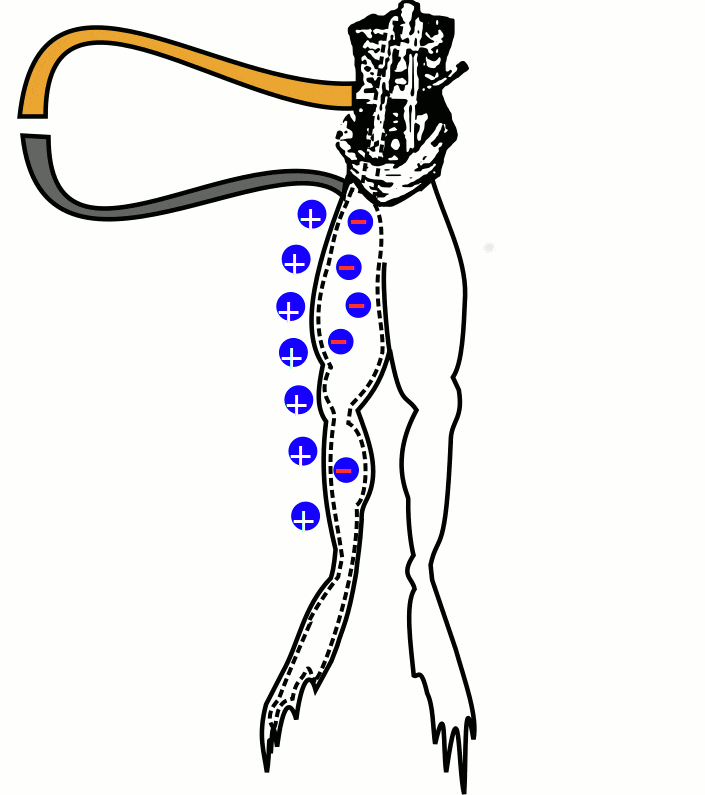
Figure 2. This animated figure shows Galvani’s understanding of animal electricity. When the bronze (yellow wire) is connected to iron (silver wire), charges flow between the frog’s positively-charged outside and the frog’s negatively-charged inside. This circuit completion causes the frog’s muscles to contract. (Figure credit: Andrew Lai)
But Volta identified a flaw in Galvani’s logic. What if the mere connection of two different metals could create electrical current? Volta set to work, trying many different combinations of metals. Silver touching copper? Electrical current. Iron touching zinc? Electrical current. With this evidence, Volta argued that the two metals created an electrical current; thus, the metals alone were responsible for the twitches. Bi-metal electricity left no room for intrinsic animal electricity.
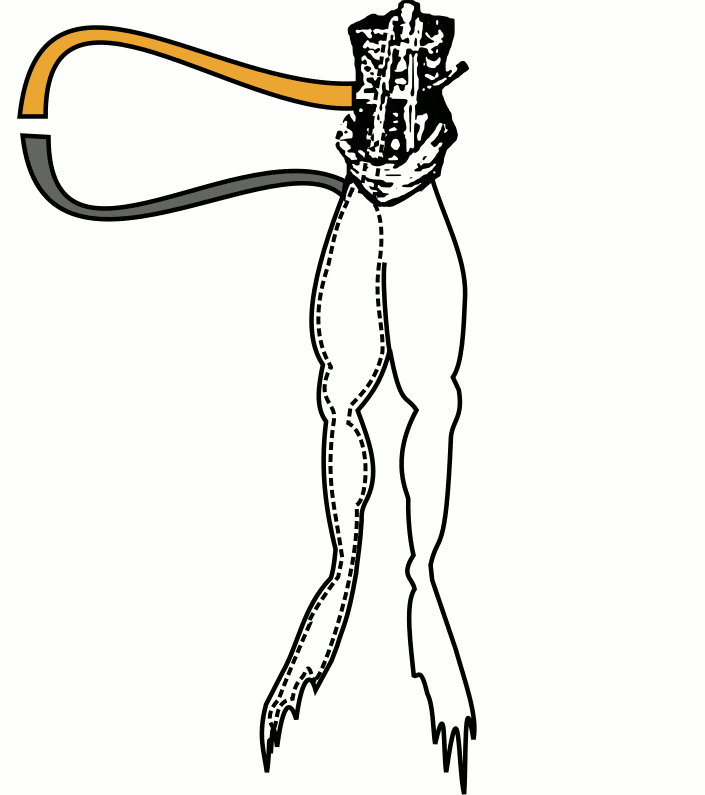
Figure 3. This animated figure shows Volta’s understanding of animal electricity. When the bronze (yellow wire) is connected to iron (silver wire), the two metals create electrical current. This causes the frog’s muscles to contract. (Figure credit: Andrew Lai)
The ensuing debate over animal electricity led Volta to publish his theory of bi-metal electricity in 1800. In it, he described how contact between dissimilar metals creates electrical current. He also described a grand new invention based off this principle: the Voltaic pile (better known today as the battery).
In the early 19th century, the Voltaic pile was revolutionary. With the device, scientists could create a steady source of electricity for the very first time. Harnessing electricity led directly to advances in chemistry, physics, and physiology. Even today, we continue to reap the benefits of the battery – a battery is probably even powering the digital display of this article! This invention would prove one of the most important and impactful inventions in history. And, as a testament to that impact, the standard unit of electric potential still bears Volta’s name: the Volt.
While scientists like Volta were busy debating the merits of Galvani’s theory, a third shockwave crashed into lives of non-scientists. As the theory spread, the concept of animal electricity was seized upon by private citizens.
Around the turn of the 19th century, demonstrations of Galvanism became fashionable in high society. Wealthy socialites hosted experiments to see the results firsthand, often to the amazement of their guests. At one memorable dinner party in Turin during the spring of 1792, one guest, the English Baroness Elizabeth Lady Holland, found the electrification of a dead frog so disturbing that she wrote about it her diary.
Even outside of the social elite, stories of electrified bodies spread through newspapers and media. Public demonstrations took place in town squares and city centers. These demonstrations were made typically made on dismembered animals, until Galvani’s own nephew, Aldini, outdid his fellow scientists by publicly electrocuting a recently executed criminal. His demonstration showed that the dead could be “reanimated” by applying electric shocks to the corpse (1803).
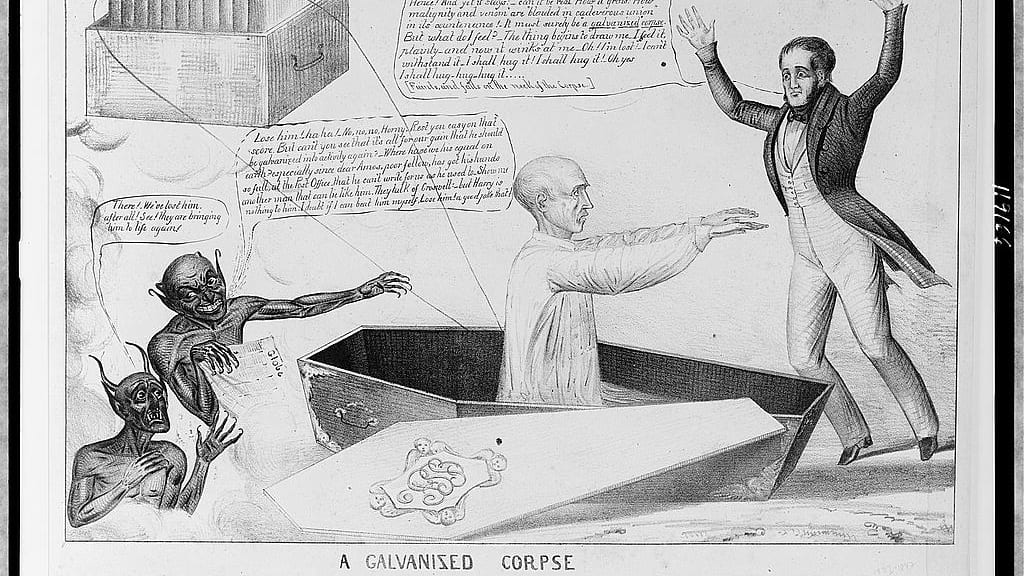
Figure 4. A Galvanized corpse. Published in 1836, this cartoon depicts Galvani’s nephew electrifying a criminal’s corpse.
The macabre scenes of electrified bodies and the idea of reanimation invaded the public zeitgeist. The public fervor even swept up artists and poets like Gothic novelist Mary Shelley. After a summer in Italy discussing Galvani’s work and other scientific discoveries with her husband, poet Percy Bysshe Shelley, and their friend Lord Byron, Mary Shelley invoked similar experiments in her most famous novel, Frankenstein, “Perhaps a corpse would be re-animated; galvanism had given a token of such things.” To Shelley and others, animal electricity brought on philosophical and religious questions as well as scientific. Could the dead be brought back to life? What would it mean for the nature of the soul, if humans were nothing more than electrical generators?
Unfortunately for the man who brought animal electricity to the world, Galvani would not have long to contemplate its widely felt implications. In 1798, only seven years after Galvani’s ground breaking publication, Napoleon marched through Italy. Napoleon’s conquest presented Galvani with a choice: swear allegiance to the Emperor’s newly created Cisalpine Republic or be removed from his academic post. Galvani refused. As a religious man, he could not declare allegiance to Napoleon’s atheistic government. With his refusal, Galvani lost his job and died within the year. Largely discredited due to the scientific battle with Volta, Galvani died poor and obscure. But today we know that he catalyzed change in medical and physical science.
Galvani’s story is one of interactions: metal and frogs, scientists and other scientists, geopolitics and a lone professor, science and people’s imaginations. These complex interactions gave rise to an incredible array of new ideas: an understanding of the body’s electrical signaling, entire new fields of study, batteries, and even a timeless monster. Like many great discoveries, the story of Galvani and animal electricity defies easy categorization. It is more than a story about science; it is the story of many fields, from technology to literature. It is a story of excitement and inspiration. It is a story of scientifically-minded people, of religious people, of everyday people.
And, at its core, it is a story of far-reaching connections.
